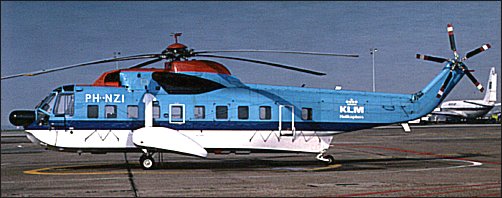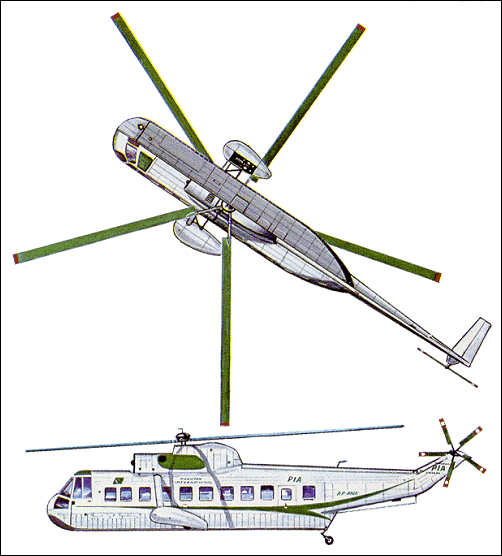
| Sikorsky S-61N 1965 |  |
 |

| Sikorsky S-61N 1965 |  |
 |
|
The commercial models of the military S-61, or SH-3, helicopter use the same rotor system with a new and longer fuselage. The S-61L is a landplane model, although its hull is sealed against the possibility of making an emergency landing on water, and all undercarriage units are non-retracting. It seats 28 passengers in the standard airline seating layout and carries a flight crew of 3. The S-61N, which carries 2 fewer passengers, is fully amphibious and can be identified by its twin stabilising floats, into which the main landwheels can be retracted. First flights of the L and N versions were made on 6 December 1960 and 7 August 1962 respectively. The type received FAA certification - the first for a twin-turbine commercial helicopter - in November 1961 and since October 1964 has been cleared for all-weather operation. Current production examples have 1500shp CT58-140 shaft turbines. The only customer so far for the S-61L has been Los Angeles Airways, which has a fleet of seven and on 1 March 1962 became the first operator to put the commercial S-61 into service. Customers up to January 1968 for the S-61N have been British European Airways (four); Greenlandair (four); Pakistan International and San Francisco & Oakland (three each); Helibuss of Norway (two); and Ansett/A.N.A., Brunei Shell Petroleum, the Canadian Dept. of Transport, Elivie of Italy, Japan Air Lines, KLM, Nitto Airways and Petroleum Helicopters Inc. (one each). K.Munson "Helicopters And Other Rotorcraft Since 1907", 1968  The three commercial models of the S-61 — the S-61L, S-61N and the Payloader — used the same dynamic components as the military version, but had a longer fuselage. The S-61L (land version with non-retractable landing gear) could carry 30 passengers and a crew of three while the S-61N, which had amphibious capability, was distinguished by two sponsons into which the landing gear retracted. The former flew on 6 December 1960 and received FAA type approval in November 1961. The main operator of the S-61L was Los Angeles Airways (6), which was the first company in the world to use Sikorsky helicopters. The interior of the S-61N was quite elaborately fitted-out; the spacious cabin had a toilet, storeroom and luggage compartment, and could accommodate 26-28 passengers. Operators of the S-61N included New York Airways (4), Nippon Airways (1), British Airways Helicopters (26), Bristow Helicopters (28), Brunei Shell (2), Elivie (2), Greenlandair (5), Helikopter Service Norway (10), Japan Air Lines (1) and KLM (2). G.Apostolo "The Illustrated Encyclopedia of Helicopters", 1984
|